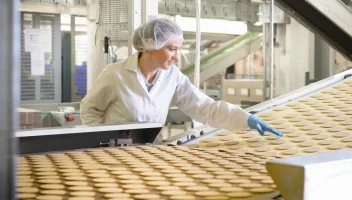Food Traceability Final Rule: Additional Guidance on the FDA’s New Regulations
Food Traceability Final Rule: Additional Guidance on the FDA’s New Regulations
Food Traceability Final Rule: Additional Guidance on the FDA’s New Regulations
Jan 23, 2025
John McCurdy
To say that food safety is under heavy scrutiny in the U.S. right now would be something of an understatement. The E coli outbreak linked to slivered onions used on McDonald’s hamburgers is just the latest on a list of serious incidents that includes Listeria contaminations at Boar’s Head, accidental inclusion of lead chromate in cinnamon applesauce and the devastating infant formula recall of 2022 due to Cronobacter sakazakii infections.
Thankfully, the Food and Drug Administration (FDA) is already in the process of ushering in the New Era of Smarter Food Safety, which will see the establishment of the Human Foods Program (HFP). A key component of the plan is the implementation of Section 204(d) of the Food Safety Modernization Act (FSMA), and it’s coming in the form of Requirements for Additional Traceability Records for Certain Foods—or, as it is more commonly known, the Food Traceability Final Rule.
Seeing as you’re a food and beverage industry professional, we know that doesn’t come as news to you. The rule was proposed back in September 2020 and then published in the Federal Register in November 2022, and we’ve covered both the basic components of it and how enterprise resource planning (ERP) software can help your business prepare for it here on our blog.
But now, with additional guidance having been released and the enforcement date of July 2028 (extended 30 months beyond the original date of January 20, 2026 in March 2025) approaching, it’s a good idea for you to brush up on what we already knew and learn the specifics provided in the FDA’s most recently released content on the subject. That way, you can identify any additional measures that your organization will need to take to be entirely compliant under the law.
A Brief Refresher: The Established Facts
As we previously mentioned, the FDA has already provided a good amount of information on the Rule, including the key terms to know and their definitions, as well as some of the specifics on what data needs to be captured and when. If you’re confident that you know the basics, feel free to skip this section, but you still may appreciate a brief overview to jog your memory.
The Food Traceability List
The most important component of the Rule is the Food Traceability List (FTL), a set of 16 foods for which additional tracking requirements are to be imposed. By scanning through the items, you should fairly quickly be able to determine whether your business is likely to be subject to the new regulation.
That is to say, if your organization grows, manufactures, processes, packs or holds a food on this list, there’s a high probability that the Rule will apply to your organization.
Cheese (including fresh soft, soft unripened, soft ripened and semi-soft cheeses made from pasteurized milk, as well as cheeses made from unpasteurized milk, except for hard cheeses)
Shell eggs (of the domesticated chicken)
Nut butters (including all tree nut and peanut butters in shelf stable, refrigerated or frozen form)
Fresh cucumbers
Fresh herbs*
Fresh leafy greens* (except whole head cabbages and leafy greens grown on trees)
Fresh-cut leafy greens (including single and mixed fresh-cut greens)
Fresh melons
Fresh peppers
Fresh sprouts
Fresh tomatoes
Fresh tropical tree fruits* (except tree nuts, pit fruits and citrus fruits)
Fresh-cut fruits*
Fresh-cut vegetables*
Finfish (fresh, frozen or previously frozen; specifically histamine-producing species, species potentially contaminated with ciguatoxin and many species not associated with histamine or ciguatoxin)
Smoked finfish (refrigerated, frozen or previously frozen)
Crustaceans (fresh, frozen or previously frozen)
Molluscan shellfish (i.e. bivalves; fresh, frozen or previously frozen; some exceptions under 21 CFR 1.1305(e))
Ready-to-eat deli salads (refrigerated; does not include meat salads)
For further information on the FTL, consult the FDA’s official page on the subject.
* With exceptions listed under 21 CFR 112.2(a)(1).
Key Data Elements and Critical Tracking Events
Two other integral parts of the rule are Key Data Elements (KDEs) and Critical Tracking Events (CTEs). As concepts, both were originally introduced by the Institute of Food Technologies back in 2012, but it’s only now that they’ve been codified into law and required for FTL foods. These can be thought of as, respectively, “what” additional data you’ll be required to capture and “when” you’ll need to capture it.
When the rule was published, the FDA gave examples of KDEs—including origin, date of production, quantity/weight, shipping dates and traceability lot codes (TLCs). CTEs, meant to align with steps in the supply chain, were enumerated as:
Creating – The act of producing a food
Growing – The act of planting and harvesting a food
Receiving – The act of receiving a food on the part of a customer (but not the end consumer)
Shipping – The act of transporting a food
Transforming – The act of changing a food, including its packaging or label
The FDA’s latest guidance includes much more information on KDEs and CTEs, including specifics and additions, but we’ll get to that in the next section.
Getting Up to Speed: The Recent Updates
In September 2024, the FDA announced a collaboration with the Reagan-Udall Foundation, which began with several roundtable discussions with industry experts, to support its efforts to implement the Rule and establish the HFP. Shortly after, significant additional guidance on the Rule was released to help business leaders prepare their organizations for compliance.
We’ve summarized this newest information below, sorted by topic.
Exemptions
We knew that some businesses would be exempt from the additional tracking requirements of the Rule, but now we have an interactive online tool that can help you determine your status by answering a few simple questions about your company and its operations. As you might expect, it begins with a question to determine whether your organization handles any FTL foods, as that’s the simplest way to rule out or confirm that the Rule will apply.
Assuming that the respondent’s organization does deal in FTL foods, the tool then prompts the user to explore the different categories of exemptions, including those for:
Farms – Some exemptions under 21 CFR 112.4(a); for farms with average annual sales revenue over the past 3 years less than $25,000; for farms with less than 3,000 hens; and farms that ship food in the packaging that will be received by the end consumer
Commingled Raw Agricultural Commodities (RACs) – Some exemptions for businesses handling raw agricultural commodities combined or mixed after harvesting but before processing
Fishing vessels and molluscan shellfish – Some exemptions for owners of vessels; companies that obtain FTL foods directly from owners of vessels; and companies handling specific varieties of raw bivalve molluscan shellfish
Retail food establishments (RFEs) – Some exemptions for RFEs with average annual sales revenue over the past 3 years less than $250,000 and for RFEs that handle FTL foods on behalf of other RFEs
Certain types of processors – Some exemptions for processors that follow special treatment procedures meant to minimize potential public health consequences
Personal consumption – Some exemptions for businesses holding FTL foods on behalf of specific individual customers and producers of FTL foods for personal consumption
Other – Some exemptions for companies handling produce rarely consumed raw under 21 CFR 112.2(a)(1); farms that sell to schools or institutions; businesses holding FTL foods under exclusive jurisdiction of the U.S. Department of Agriculture; transporters of food; non-profit organizations; and businesses using FTL foods solely for research purposes
If you believe your organization may be exempt from the Rule but are not sure even after using the tool and reviewing the supplementary materials, you should seek a qualified opinion to ensure that you do not violate the new regulations.
Further Details on CTEs and KDEs
The FDA has expanded the list of CTEs and enumerated the specific KDEs required for each, as detailed in this new guide. CTEs are now defined as the following:
Harvesting – The act of removing an RAC from the place they’re grown or raised to prepare for use as food, applying to farms and related facilities
Cooling – The act of reducing the temperature of an RAC
Initial Packing – The act of packing an RAC for the first time (other than a food obtained from a fishing vessel)
First Land-Based Receiving – The act of taking possession of a food from a fishing vessel and bringing it on land for the first time
Shipping – The act of transporting a food from one location to another, not including intracompany transport, donations or shipment directly to a consumer
Receiving – The act of receiving a food after it has been transported
Transformation – The act of manufacturing, processing or otherwise changing a food or its packaging/packing
The number of KDEs for each CTE ranges from three to 15 and may vary based on where the food was received from and whether or not the FTL food will be used as an ingredient.
Traceability Lot Codes
The idea of using lot codes for food traceability is nothing new, but the term TLC as it is defined under the Rule entails specific requirements and procedures for businesses handling FTL foods. On its webpage dedicated to the topic, the FDA gives examples of acceptable TLC formats (including GS1-128 barcodes, internally assigned codes, Julian date codes and more), as well as more information on source and reference requirements for TLCs.
If an FTL food does not already have one, a business must assign a unique TLC at the initial packing CTE for RACs (or the first land-based receiving CTE for foods obtained from a fishing vessel) and/or the transformation CTE. Once a food has been assigned a TLC, all KDE records for applicable CTEs must be linked to that TLC.
Traceability Plans
As is the case for lot codes, traceability plans are a familiar concept for modern food and beverage businesses, but the term takes on a specific meaning under the Rule. Specifically, companies that handle FTL foods must establish and maintain a plan with the following information:
A description of your procedures for maintaining records required under the Rule, including the format and location of those records
A description of your procedures for identifying FTL foods that you manufacture, process, pack or hold
A description of how you assign TLCs
The point of contact at your business for questions regarding your traceability plan and records
If you grow or raise FTL foods other than shell eggs, a map indicating the areas in which they are grown or raised
Additionally, the required records must be maintained as originals (paper or electronic) or true copies, and they must be stored to prevent deterioration and loss. Any information required to understand your records must be made available to the FDA within 24 hours of a request, and an electronic sortable spreadsheet containing relevant traceability information must be provided to the FDA within 24 hours of request in the event of a food safety emergency.
To help you understand what is necessary for a Traceability Plan according to your company’s situation, the FDA has provided examples for farms, restaurants and sprouters.
Tackling Compliance With Technology
The Food Traceability Final Rule sets the bar for tracking products with inherent food safety risks higher than it has ever been before. That’s good news for consumers and a step forward for the industry as a whole, but it will demand much more from businesses that handle FTL foods in terms of record keeping, attention to detail and accountability to the FDA. Long gone are the days when “one step forward, one step back” was considered sufficient for recalls and public health.
If your organization is in the market for technology to facilitate compliance with the new regulations, you should consider industry-specific enterprise resource planning (ERP) software as your highest priority. That’s because these solutions pack not only mission-critical functionalities for finances and sales, but also specialized tools for item-level visibility and automated data capture that make adhering to the Rule’s requirements much easier.
Our own Aptean Food & Beverage ERP is developed by hundreds of dedicated and passionate food and beverage professionals with hundreds of years of collective experience in the industry. It comes packed with the features you need to facilitate compliance with FDA regulations, including the Rule and many more, built on the robust Microsoft Business Central platform and hosted in the world’s most secure cloud environment.
What’s more, we’re embedding AI capabilities in our systems as part of our dedication to innovation and commitment to giving our customers the cutting-edge enhancements necessary for competing in a dynamic landscape. When you choose us as your software provider, you’re securing a long-term partner that’s dedicated to mutual success and future growth.
To quickly get an idea of how prepared your business is for compliance with the Food Traceability Final Rule, make sure to take our interactive quiz.
For more information on Aptean Food & Beverage ERP and how it can help your company comply with the Food Traceability Final Rule, contact us today. You can also request a personalized demo to see the solution in action for yourself.
Related Content





Get in touch today to speak with an expert in your industry
To grow your business, you need a food ERP built specifically for your industry challenges. We're ready to help—reach out today and we'll help you find the right solution.



